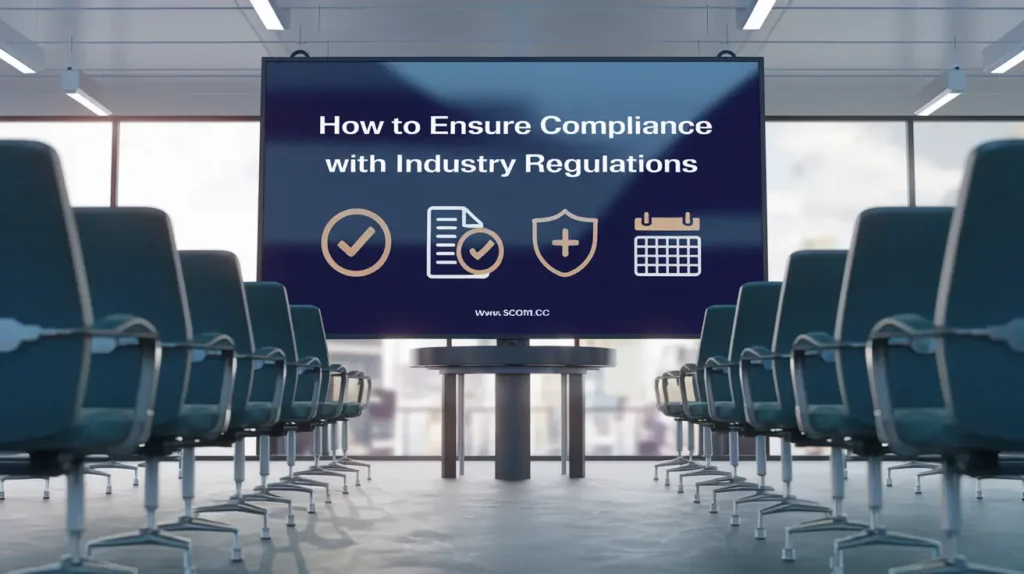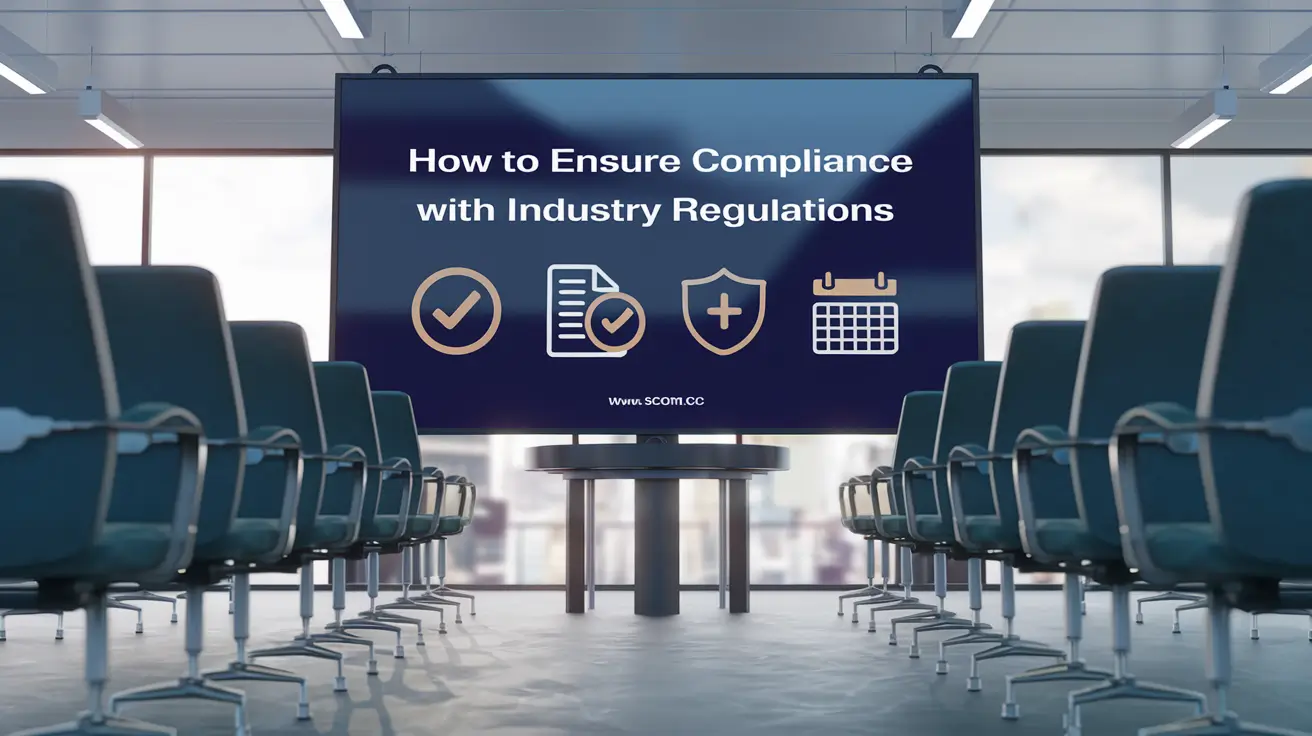How to Ensure Compliance with Industry Regulations

- How to Ensure Compliance with Industry Regulations
- Understanding Industry Regulations
-
Steps to Ensure Compliance with Industry Regulations
- Understand Applicable Regulations
- Implement Compliance Policies and Procedures
- Train Employees on Compliance
- Monitor and Audit Compliance
- Stay Updated on Regulatory Changes
- Engage with Regulatory Bodies
- Implement Risk Management Practices
- Ensure Data Protection and Privacy
- Review and Improve Compliance Practices
- Document and Report Compliance Efforts
- Examples of Compliance Best Practices
- Summary Table
-
FAQ
- What are the first steps to understanding industry regulations for my business?
- How can I develop effective compliance policies and procedures?
- What are the best practices for training employees on compliance?
- How often should I conduct compliance audits?
- How can I stay updated on regulatory changes?
- What should I include in a risk management plan for compliance?
- How can I ensure the protection of sensitive data in compliance with regulations?
How to Ensure Compliance with Industry Regulations
Ensuring compliance with industry regulations is essential for maintaining operational integrity, avoiding legal issues, and building trust with customers. Regulations vary by industry and jurisdiction, but all share the common goal of ensuring safety, fairness, and accountability. This guide provides a comprehensive overview of strategies to ensure compliance with industry regulations.
Understanding Industry Regulations
What Are Industry Regulations?
Industry regulations are rules and standards established by governmental bodies or industry organizations to govern practices within specific sectors. These regulations aim to ensure that businesses operate safely, ethically, and legally. They may cover a range of issues, including safety standards, financial reporting, data protection, and consumer rights.
Why Compliance Is Important
Compliance with industry regulations is crucial for several reasons:
- Legal Protection: Adhering to regulations helps avoid legal penalties, fines, and lawsuits.
- Operational Efficiency: Regulatory compliance often requires implementing best practices that can improve overall efficiency.
- Reputation Management: Compliance enhances a company's reputation by demonstrating a commitment to ethical practices and consumer protection.
- Customer Trust: Meeting regulatory standards builds customer trust and confidence in your products or services.
Steps to Ensure Compliance with Industry Regulations
Understand Applicable Regulations
Understanding which regulations apply to your business is the first step in ensuring compliance.
- Identify Relevant Regulations: Research and identify all regulations relevant to your industry, including local, national, and international laws.
- Consult Industry Guidelines: Refer to industry-specific guidelines and standards issued by professional organizations and regulatory bodies.
- Seek Expert Advice: Consult legal and regulatory experts to ensure a comprehensive understanding of applicable regulations.
Implement Compliance Policies and Procedures
Establishing clear policies and procedures is essential for maintaining compliance.
- Develop Compliance Policies: Create written policies that outline how your business will comply with relevant regulations. Include guidelines for handling data, safety practices, and financial reporting.
- Implement Procedures: Develop and implement procedures to ensure that policies are followed. This may include protocols for data protection, employee training, and safety inspections.
- Document Everything: Keep detailed records of policies, procedures, and compliance activities to provide evidence of adherence during audits.
Train Employees on Compliance
Employee training is crucial for ensuring that all staff members understand and adhere to compliance requirements.
- Conduct Regular Training: Provide regular training sessions on regulatory requirements and compliance procedures. Update training materials as regulations change.
- Make Training Accessible: Ensure that training is accessible to all employees, including new hires and those in different locations.
- Assess Understanding: Use quizzes, assessments, and feedback to evaluate employees' understanding of compliance requirements.
Monitor and Audit Compliance
Ongoing monitoring and auditing are necessary to ensure continued compliance.
- Conduct Regular Audits: Perform regular internal audits to assess compliance with regulations and identify areas for improvement.
- Use Compliance Tools: Implement compliance management software to track and monitor adherence to regulations. These tools can help with documentation, reporting, and risk management.
- Address Issues Promptly: Identify and address any compliance issues or gaps immediately to prevent potential violations.
Stay Updated on Regulatory Changes
Regulations are subject to change, so staying updated is essential for ongoing compliance.
- Monitor Regulatory Updates: Regularly review updates from regulatory bodies and industry organizations to stay informed about changes in regulations.
- Subscribe to Alerts: Subscribe to newsletters, alerts, or updates from regulatory agencies and industry associations to receive timely information about regulatory changes.
- Adjust Policies and Procedures: Revise your policies and procedures as needed to reflect new or updated regulations.
Engage with Regulatory Bodies
Building a positive relationship with regulatory bodies can facilitate compliance and provide valuable insights.
- Participate in Industry Forums: Engage in industry forums, workshops, and conferences to stay informed about regulatory developments and best practices.
- Seek Guidance: Contact regulatory bodies for guidance on compliance issues or to clarify regulatory requirements.
- Report Issues Transparently: If compliance issues arise, report them to regulatory bodies transparently and work towards resolving them in cooperation with the authorities.
Implement Risk Management Practices
Risk management practices help mitigate the impact of non-compliance and other risks.
- Conduct Risk Assessments: Perform regular risk assessments to identify potential compliance risks and vulnerabilities.
- Develop a Risk Management Plan: Create a risk management plan that outlines strategies for mitigating identified risks and responding to potential compliance issues.
- Establish Contingency Plans: Develop contingency plans for handling non-compliance incidents and regulatory inquiries.
Ensure Data Protection and Privacy
Data protection and privacy are critical aspects of regulatory compliance.
- Implement Data Security Measures: Use encryption, access controls, and other security measures to protect sensitive data.
- Comply with Data Protection Laws: Adhere to data protection laws such as GDPR, CCPA, or other relevant regulations in your jurisdiction.
- Train Employees on Data Privacy: Educate employees about data protection best practices and their role in maintaining data privacy.
Review and Improve Compliance Practices
Continuous improvement of compliance practices helps ensure long-term adherence to regulations.
- Evaluate Compliance Programs: Regularly review and evaluate the effectiveness of your compliance programs and practices.
- Solicit Feedback: Seek feedback from employees, auditors, and other stakeholders to identify areas for improvement.
- Implement Improvements: Make necessary adjustments and improvements based on evaluations and feedback.
Document and Report Compliance Efforts
Proper documentation and reporting are essential for demonstrating compliance.
- Maintain Records: Keep detailed records of compliance activities, audits, training, and communications with regulatory bodies.
- Prepare Reports: Prepare and submit required reports and documentation to regulatory agencies as needed.
- Review Documentation: Regularly review and update documentation to ensure accuracy and completeness.
Examples of Compliance Best Practices
Financial Industry: SOX Compliance
In the financial industry, the Sarbanes-Oxley Act (SOX) requires companies to implement strict internal controls and reporting standards. Companies often use compliance management systems and regular internal audits to ensure adherence to SOX requirements. These practices include:
- Regular Financial Audits: Conducting regular internal and external audits to ensure accuracy in financial reporting.
- Segregation of Duties: Implementing controls to separate key financial responsibilities and prevent fraud.
- Documentation: Maintaining comprehensive records of financial transactions and internal controls.
Healthcare Industry: HIPAA Compliance
In the healthcare industry, the Health Insurance Portability and Accountability Act (HIPAA) mandates stringent rules for protecting patient data. Best practices for HIPAA compliance include:
- Data Encryption: Using encryption to secure patient information both in transit and at rest.
- Employee Training: Providing ongoing training for healthcare staff on privacy and security practices.
- Regular Audits: Conducting regular security audits to identify and address vulnerabilities.
Retail Industry: PCI DSS Compliance
Retail businesses must comply with the Payment Card Industry Data Security Standard (PCI DSS) to protect customer payment information. Best practices include:
- Secure Payment Systems: Implementing secure payment processing systems and regular vulnerability scans.
- Access Controls: Restricting access to payment data to authorized personnel only.
- Regular Training: Educating staff on secure handling of payment information and fraud prevention.
Summary Table
| Strategy | Description | Benefits | Implementation Tips |
|---|---|---|---|
| Understand Applicable Regulations | Research and identify relevant regulations and guidelines | Ensures comprehensive compliance understanding | Consult legal experts, refer to industry guidelines |
| Implement Compliance Policies and Procedures | Develop and implement written policies and procedures | Provides clear guidelines and documentation for compliance | Document policies, streamline procedures |
| Train Employees on Compliance | Provide regular training on compliance requirements | Ensures staff understand and follow regulations | Conduct training sessions, assess understanding |
| Monitor and Audit Compliance | Regularly monitor and audit compliance practices | Identifies and addresses compliance issues promptly | Use compliance tools, perform internal audits |
| Stay Updated on Regulatory Changes | Keep informed about changes in regulations | Ensures ongoing compliance with the latest requirements | Subscribe to updates, review regulatory changes |
| Engage with Regulatory Bodies | Build relationships and seek guidance from regulatory bodies | Facilitates understanding of regulations and addressing issues | Participate in forums, contact regulatory bodies |
| Implement Risk Management Practices | Assess and manage compliance risks | Mitigates impact of non-compliance and other risks | Develop risk management plans, conduct assessments |
| Ensure Data Protection and Privacy | Implement measures to protect sensitive data | Complies with data protection laws and safeguards information | Use encryption, adhere to privacy laws |
| Review and Improve Compliance Practices | Continuously evaluate and improve compliance practices | Enhances effectiveness and addresses areas for improvement | Seek feedback, implement improvements |
| Document and Report Compliance Efforts | Maintain records and prepare reports for regulatory agencies | Demonstrates adherence to regulations and supports audits | Keep accurate records, prepare required reports |
FAQ
What are the first steps to understanding industry regulations for my business?
Start by researching regulations specific to your industry and jurisdiction. Consult industry guidelines, seek expert advice from legal or compliance professionals, and stay informed about relevant laws and standards.
How can I develop effective compliance policies and procedures?
Create written policies that outline compliance requirements and procedures for your business. Ensure these are documented clearly and implemented consistently across your organization. Regularly review and update policies as regulations change.
What are the best practices for training employees on compliance?
Provide regular, comprehensive training on regulatory requirements and compliance procedures. Make training accessible to all employees and use assessments to gauge understanding. Update training materials as regulations evolve.
How often should I conduct compliance audits?
Conduct regular internal audits based on the size and complexity of your organization, typically on an annual basis. Perform additional audits if there are significant regulatory changes or if compliance issues arise.
How can I stay updated on regulatory changes?
Subscribe to newsletters or alerts from regulatory bodies and industry associations. Attend industry conferences and forums, and regularly review updates from relevant authorities to stay informed about changes.
What should I include in a risk management plan for compliance?
Include strategies for identifying, assessing, and mitigating compliance risks. Develop contingency plans for handling non-compliance incidents and establish protocols for monitoring and managing risks effectively.
How can I ensure the protection of sensitive data in compliance with regulations?
Implement strong data security measures, such as encryption and access controls, to protect sensitive information. Adhere to data protection laws like GDPR or CCPA, and regularly train employees on data privacy practices.

If you enjoyed this article and found it valuable, we encourage you to explore our news and valuable information section, where you'll find more relevant and up-to-date content that may pique your interest. Additionally, if you are seeking advice or need guidance on a specific topic, we suggest visiting our services section. There, you will find a variety of options designed to assist and support you in addressing your needs. Feel free to check out both sections to get the information and assistance that best suits your requirements.

Leave a Reply